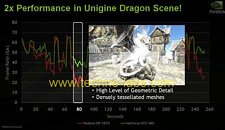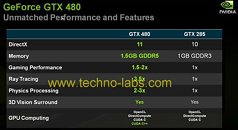Friday, March 19th 2010

NVIDIA Claims Upper Hand in Tessellation Performance
A set of company slides leaked to the press reveals that NVIDIA is claiming the upper hand in tessellation performance. With this achievement, NVIDIA is looking to encourage leaps in geometric detail, probably in future games that make use of tessellation. NVIDIA's confidence comes from the way its GF100 GPU is designed (further explained here). Each GF100 GPU physically has 16 Polymorph Engines, one per streaming multiprocessor (SM) which helps in distributed, parallel geometry processing. Each Polymorph Engine has its own tessellation unit. With 15 SMs enabled on the GeForce GTX 480 and 14 on the GeForce GTX 470, there are that many independent tessellation units.
NVIDIA demonstrated its claims in the presentation using the Unigine Heaven, where the GeForce GTX 480 was pitted against a Radeon HD 5870. In many scenes where tessellation is lower, the GPUs performed neck-and-neck, with the GTX 480 performing better more often. But in scenes with heavy tessellation (particularly the "dragon" scene, where a highly detailed model of a dragon needs to be rendered with densely tessellated meshes, the GTX 480 clocks nearly a 100% performance increment over the HD 5870. NVIDIA has been confident about the tessellation performance back since January, when it detailed the GF100 architecture. The GeForce GTX 400 series graphics cards will be unveiled on the 26th of March.Images Courtesy: Techno-Labs
NVIDIA demonstrated its claims in the presentation using the Unigine Heaven, where the GeForce GTX 480 was pitted against a Radeon HD 5870. In many scenes where tessellation is lower, the GPUs performed neck-and-neck, with the GTX 480 performing better more often. But in scenes with heavy tessellation (particularly the "dragon" scene, where a highly detailed model of a dragon needs to be rendered with densely tessellated meshes, the GTX 480 clocks nearly a 100% performance increment over the HD 5870. NVIDIA has been confident about the tessellation performance back since January, when it detailed the GF100 architecture. The GeForce GTX 400 series graphics cards will be unveiled on the 26th of March.Images Courtesy: Techno-Labs



145 Comments on NVIDIA Claims Upper Hand in Tessellation Performance
This link covers the problem well.
forums.electronicarts.co.uk/battlefield-bad-company-2-pc/928007-bc2-pc-still-slow-loading-map-good-system.html
It's to do with the drivers having to reload the map shaders each time.... NV have it sussed.
I've since changed the settings.ini file to force DX9 and it loads far quicker now. Bah ATI drivers.
Found something over at Hexus.
www.hexus.net/content/item.php?item=23032
Those damn graphs we're talking about earlier are Nvidia's own in house benchies.
Nuff said.
scroll down on that hexus chart, As most have said, nothing is real till the 26th, and its only 1 game (not to mention one of the most GPU bias-ed games ever), with an unknown system and Ive heard of this cool program called photoshop
I was actually spending a lot more time looking into the whole eyefinity thing. The videos on youtube that show no bezels actually do look pretty cool. I guess with their recording software or whatever they were able to zoom i a certain way to eliminate the bezels of their actual trimonitor setup. Over the last few years I remembered news of some developers coming out with large widescreen monitors that don't have bezels in between what would be regular monitors' resolutions in the same setup. Specifically the one from Alienware and I forget the other one. But after some research they both cost almost $8,000 ... rediculous. The bezels are still thick enough not to be seamless at a good pricepoint with current monitors on the market. Heck, even the Samsung 3 or 6 monitor display that's supposedly made with eyefinity in mind costs a heck of a lot of money.
With much less than that money, I could buy a 1080p DLP projector and project a 130" screen which would wipe the floor with eyefinity. I'm not saying ATI's technology is bad, but in the future where bezels either get ultra thin or merged monitors enter the market with no bezels, then maybe it would make more sense. I have yet to find a 1080p 3D projector for a great price, but I'm sure it would come out within the next few years. I still feel 3D is awesome for games and movies, and I have yet to hear the opposite from anyone that comes to my place to see it once in a while. Maybe you guys that are naysayers don't have it set up correctly or your display is too small?
Geforce GTX 480 TDP at 250W - www.fudzilla.com/content/view/18170/1/
That's why you can't believe any rumors and much less make any assumptions based on them. Which one is truth now? 300w? 250? You see?One word TESSELATION.
Regarding the issue with the language, I admit I overreacted, but it has nothing to do with arrogance, not mine at least. If at all it's the (probably unconscious) arrogance of the average english speaking people who always find the time to correct others people's grammar who made me write about that. That was not the case (he was not correcting), and I apologyse to the54thvoid, but it's absolutely NOT YOUR issue. I'm starting to think you are in love with me anyway, because you step up on my discussions on every oportunity you find and well, I'm not used to so much attention (it's usually me who has to go after women). Sorry, and I will do use my arrogance this time, but you are not my type.
I'm being patient with the upcoming Catalyst, are you?
I ask because you know ATI and Nvidia handle tessellation differently and therefore games that are written based off their respected hardware will perform differently. To say Nvidia does tessellation "better" is ignorant of the process.
I found this post on another forum. It may explain things better for you.www.semiaccurate.com/forums/showpost.php?p=22193&postcount=33
Note: the following material is not to be used as flame bait. It's just a joke peeps!
Not satisfied with your purchase? You expect more than just Dx11 and Physx?
Then call now and order your very own Easy-bake solution at 1-800-Half-A-Hertz
Our technology manages to harness all that unused extra power of your new GPU and focus it in two perfectly sized hot plates
You can heat up your coffee, cook a balanced breakfast or just warp up in those cold winter days.
Brought to you by your friendly Half-A-Hertz & Co. and powered by NVIDIA T.M.
No offense B, you're a smart guy, but it seems ATi definitely pee'd in your coffee at some point in time.
Got 3 days left :rockout:
I love it when they fight, now let's see prices drop, and availability improve for cards like the HD5850.
So according to this article Nvidia Fermi fails to impress. So much for ATI dropping prices :cry:
Tesselators themselves are not the problem anyway. Triangle setup is far more important. You could have a tesselator hexa or hecta pumped (or 100 tesselators), I don't care, but it wouldn't make a difference if you can only do one tri/cycle as is the case with Evergreen. Nvidia didn't put 16 tesselators because they are needed anyway, they are there to increase availability and reduce latency by giving each SM one tesselator to operate with. Tesselation performance will still be limited primarily by the tri setup and secondly by hull/domain shaders anyway (both of which Fermi seems to deal better with thanks to its L1/L2 caches), but HD5870/HD5770 demostrate that Evergreen is heavily limited by tri setup/tesselator even with the low tesselation levels found in Stalker, Dirt2, etc and not by shader performance: when tesselation is enabled the HD5770 loses much less than it's biggest brethren.